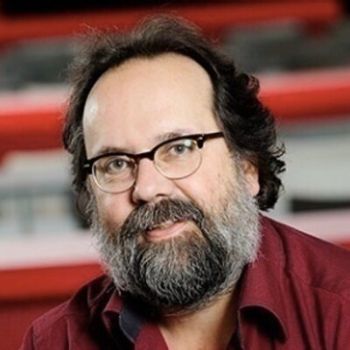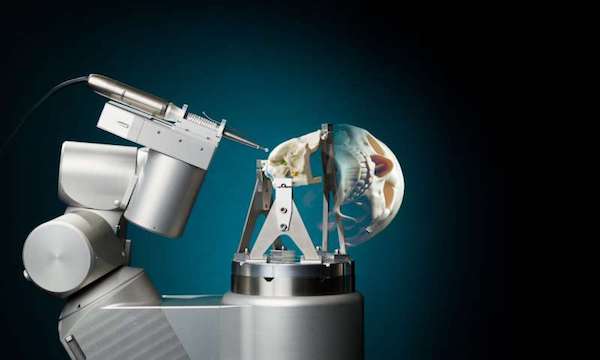(Editor’s note: You can read more here about HighTechXL’s Beyond tech conference and demo day.)
Most of us jump into startups knowing survival in this realm can be, as Thomas Hobbs put it, nasty, brutish and short.

MAARTEN STEINBUCH
The life expectancy of new companies is often short and – if the startup survives – investors typically come in at some stage and fire everyone from the founding team.
That is NOT the future of medical robotics in Eindhoven, where we like to say the future is being invented.
Robotics pioneer Maarten Steinbuch, a mechanical engineer by training, is building Eindhoven Medical Robotics with a Jeff Bezos-like 20-year vision … as an enduring business that could redefine this global semiconductor center while revolutionizing the medical world.
And he’s hiring with a goal of building EMR into a 1,000-employee company over the next 10 years … but more about that in a minute.
At last week’s HighTechXL Beyond tech conference and demo day, Steinbuch was one of 10 presenters. His talk was titled “The Future of Medical Robotics,” but he touched on multiple topics including Moore’s Law, emerging technology that will make it illegal for humans to drive cars and the reality of the Robot Revolution. (A hint: The tech behind personal robots is way too expensive right now to be practical, and it’ll be 10 years before you have a robot in your home.)
Which was all interesting until he started laying out his vision for building his business.
Lessons learned … painfully
Steinbuch is a bit like Silicon Valley legend Jim Clark, who founded multiple landmark tech businesses including Netscape and Silicon Graphics.
Developing the technology as a professor at Technical University of Eindhoven (TU/e), Steinbuch and his teams of researchers and engineers created Eindhoven’s first startup robotic surgery company back in 2010. TU/e’s Sofie robotic surgery technology competed with da Vinci Surgical Systems, a global phenomenon owned by a Silicon Valley firm, Intuitive Surgical.
He found out quickly that da Vinci “has all the patents” as well as a huge staff dedicated to specifically trying to thwart competitors, Steinbuch told the crowd.
His painful takeaway from that venture: “To do a medical robotics startup, the amount of money you need is beyond imagination if you’re a professor at a university,” at least 10 million to 20 million euros, Steinbuch said.
To get back in the game, he had to first figure out which technology could become a viable business. Rather than taking on da Vinci directly, he came up with was a master-slave system that could assist surgeons in operating on the retina, filtering out surgeon’s hand tremors. There are only a few doctors who can suture lymph nodes, for example, at 3 millimetres, “and only in the morning,” Steinbuch said. “We make super surgeons – that’s what we do.”
Making history
The next iteration of Steinbuch’s surgical robotic designers was Preceyes, founded in 2011. Oxford University bought the first Preceyes system and used it in 2016. While minimally invasive robotic surgery had become common for treating cancer and other maladies by then, the Oxford operation was the first robotic surgery inside a human eye, enabling a surgeon to remove a membrane 1/100th of a millimeter thick.
In the years since his first startup, Steinbuch has gone from one company to multiple companies under the umbrella of Eindhoven Medical Robotics, a tech transfer company that takes the most promising research technology from TU/e and transforms it into viable medical products.

ROBOSCULPT
EMR companies include:
• MicroSure, a system “designed by and for” microsurgeons.
• ReCath, a steerable catheter startup, ReCath wants to replace current catheter placement, done by hand by doctors, with a smaller catheter that can be steered from a distance, allowing for more intuitive steering. The technology reduces procedure times by more than an hour. ReCath is part of the HighTechXL accelerator cohort that finished the program last week.
• RoBoSculpt is the subsidiary Steinbuch spent the most time describing at the HighTechXL event. He said surgeon Dr. Dirk Kunst at Radboud UMC in Nijmegen asked, “Can you develop a robot for me?” Kunst needed a way to drill through the skull quickly and precisely for access to cancers, or to insert cochlear implants. The result was RoBoSculpt, a brand-new machine designed by TU/e doctoral student Jordan Bos that reduces the procedure from four hours to 30 minutes.
As you can imagine, Eindhoven Medical Robotics has gotten the attention of investors, and VCs show up regularly, Steinbuch told Dispatches. But they want a big exit in return for the capital injection while he as CEO wants to build an enduring company.
How serious is he? Well, Steinbuch just hired a computer engineer from Google to write his software.
If this sounds like a place that you might want to work, you’re in luck!
EMC has at least four openings including:
Electronics engineering team member
Responsibilities include:
- optimizing the electronics design in the surgical robots to meet the intended medical applications
- Translating regulatory standards for the EU, the US and Asia into requirments for electronics design
- Hands-on building and repairing of PCB/electronics
- Transfer of design to manufacturing while working with suppliers
- Maintaining a supplier database for electronics including overviews of bills of materials, supplier audits and component lifecycle checks.
Qualifications include five years of relevant experience in electronics related to medical device development. (Emphasis theirs.) And it would be great if you’ve participated in a medical product launch.
Medical Image Processing
You would be part of a multi-disciplinary team including system architects, mechanical, electrical and software engineers working on projects in various stages ranging from early research to pre-clinical prototypes at hospitals.
Profile: You have an MSc or Ph.D. in computer science, physics, biomedical engineering or another tech field, or practical experience with medical image processing. You should have experience developing software that has been used in a medical product and know at least one high-level programming language, preferably Python or MATLAB. And the EMR literature says it would be swell if you have developed a server-side app or have experience with JavaScript or other programming languages.
Graphical User Interfaces
EMC wants someone who can:
- develop GUIs for medical applications
- work with an agile team to develop, test and maintain desktop-based (.Net Winforms and WFP, C++ and MFC) applications built on Microsoft technologies
- learn the software development process and lifecycle of a feature request
- develop new components, features and functionality within the designated products
- troubleshoot and debug code
Qualifications include three years of programming with object-oriented programming languages and experience developing complex programs using C# and WPF.
Quality & Regulatory
Responsibilities would focus on leading the quality and regulatory process from design and development through final market release for new products.
Qualifications:
- 5-10 years of relevant experience with CE Class 2b, Class 3 medical devices; FDA experience is a plus
- Experience in design and development of medical devices
- Experience with ISO 13485 and new EU CE
- Excellent English skills both spoken and written
- Work experience in an international environment is preferred
You can apply at: [email protected] or you can email Steinbuch directly at [email protected]
Co-CEO of Dispatches Europe. A former military reporter, I'm a serial expat who has lived in France, Turkey, Germany and the Netherlands.















